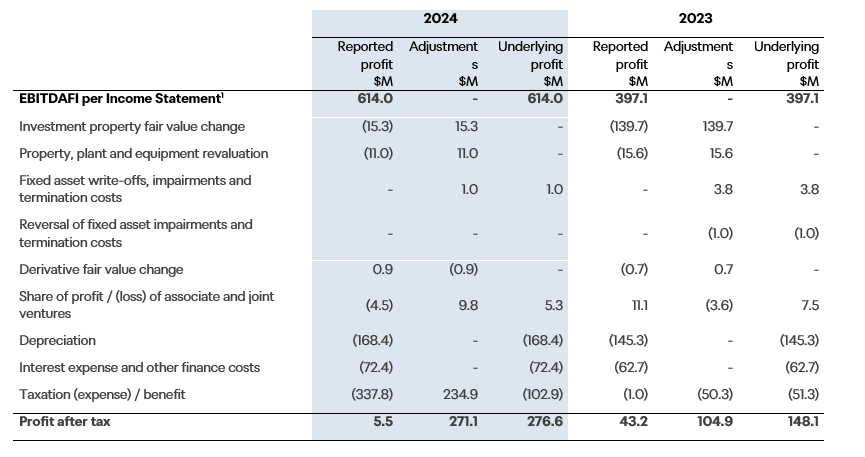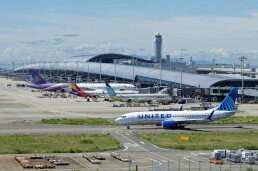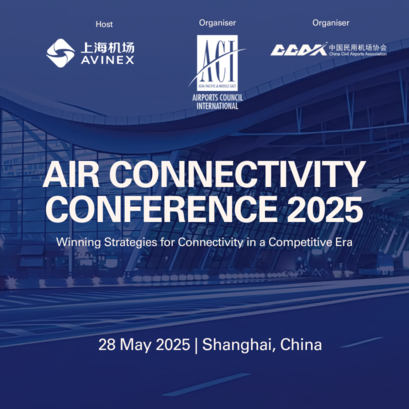
FY24 results: Solid Performance as International Airlines Return to AKL
- 2024-08-22
Key performance data for the 12 months to 30 June 2024:
- Total number of passengers increased to 18.5 million, up 17%
- Domestic passenger numbers increased 5% to 8.5 million, and international passenger numbers (including transits) increased 29% to 10.1 million
- Revenue was up 43% to $895.5 million
- Operating EBITDAFI was up 55% to $614.0 million
- Reported profit after tax was down 87% to $5.5 million
- Earnings per share was down 86% to 0.37 cents
- Net underlying profit after tax of $276.6 million, up 87%
- Net underlying profit per share of 18.75 cents
- 6.5 cents per share final dividend will be paid on 4 October 2024
Auckland Airport today announced its financial results for the year to 30 June 2024.
Auckland Airport Chair Patrick Strange said the FY24 financial year has been marked by the strong return of international airline capacity, including several new carriers and routes, with seat availability to international destinations at 91% of 2019 levels.
“The lift in capacity, particularly on North American routes with a 48% increase in available seats, has not only benefited Kiwis but led to a 40% growth in North American visitors – an important economic driver for New Zealand’s tourism industry,” said Mr Strange.
“Connectivity with China has been another bright spot with the return of Sichuan Airlines in April. Six airlines now connect Auckland Airport to seven destinations in China, with seat capacity surpassing 2019 levels by 2% for the year while Q4 saw an 13% increase.”
In total 27 airlines flew non-stop between Auckland and 42 international destinations, up from 25 airlines and 40 destinations in FY23.
“The Auckland Airport team has worked hard to bring back airlines to Auckland, supporting them to grow and relaunch services, and that has delivered choice and competitive fares for customers.
“Where there is less capacity and competition on routes, airfares remain stubbornly high, most noticeably across the Tasman. When you couple the higher cost of flying with increased competition from other tourism destinations and the economic climate globally, we’ve seen flow-on impacts for key inbound visitor markets. This is especially true for Australia, with fewer Australians choosing New Zealand as their destination.
“Looking ahead, a global backlog of replacement aircraft orders has seen airlines prioritising available fleet on high-yield routes and holding back on a full return to long-haul destinations.
“With these headwinds, we are anticipating a longer timeframe for achieving a full capacity recovery to pre-2019 levels.”
Chief Executive Carrie Hurihanganui said while FY24 had brought an uplift in airline seat capacity, Auckland Airport was taking a careful approach to managing costs due to the current economic environment.
“Auckland Airport relies on customers coming and going through our doors so in this environment, where people are being more careful with household spending, we are taking a prudent and careful approach to spending.
“This conscientious approach to cost control extends to our infrastructure programme, with a firm focus on functional, fit-for-purpose facilities delivered in an efficient and cost-effective manner.
“We’re making positive progress in this regard and this past year has seen the visible changes underway across the airport precinct: The first stage of the Transport Hub opening and the closure of the inner terminal road; work on our airfield expansion; road network upgrades; and importantly, real progress on the new domestic jet terminal.
“We are confident that we are delivering the much-needed upgrade and renewal of an airport that serves as the gateway for more than 18 million travellers and $26 billion in annual trade. The recent release of the Commerce Commission’s draft conclusions on the Pricing Setting Event 4 confirmed Auckland Airport’s infrastructure programme was on the right track.
“We welcomed the Commission’s draft conclusion that Auckland Airport had carried out extensive consultation with airlines and the rigour applied to planning and costing the investment, which benchmarked well internationally.
“The Commission also acknowledged the importance of timely investment to ensure Auckland Airport is a resilient, efficient and well-functioning airfield and international gateway for New Zealand, saying: “Our draft conclusion is that there appear to be operational and financial reasons for Auckland Airport to proceed with the TIP (terminal integration programme) now. If the investment is deferred because the cost to build and associated increases in airport charges are considered too high, postponing the same investment into the future is unlikely to address this concern.”
In its draft report, the Commission questioned the weighted average cost of capital Auckland Airport used to set prices, suggesting a lower value might be appropriate. In particular, the Commission shared a different interpretation regarding how the effects of the pandemic should be considered.
“We are committed to fully engaging with the next round of submissions on the Commission’s draft report, including providing further context on how we considered the impact of the pandemic.
“This is the robust regulatory regime at work, one that balances the needs of travellers with the level of investment needed to maintain a well-functioning airport.”
Building for the long haul
Auckland Airport’s terminal integration programme continues to proceed at pace, with the project now more than 20% complete.
The external structure of a major building block known as ‘the Stitch’ – the new connection point between the international terminal and new domestic jet terminal – is almost complete, with the baggage hall on the ground floor operating.
“As New Zealand’s gateway, our terminal integration project is not only important for how we connect with the world – it’s also an enabler for our nation’s prosperity in terms of both tourism and trade,” said Ms Hurihanganui. “We already have more than 1,000 people working on sites across the precinct including in planning and design. We expect job numbers to peak at around 2,000 people employed in roles associated with the infrastructure programme across the delivery of the new jet terminal during its construction.
“For many this will be a highlight in their career, not only learning skills to take on to their next role but doing so in the knowledge they played a part in creating something of enormous economic and social benefit for Aotearoa New Zealand.”
Alongside the main terminal construction, work is underway on an airfield expansion the size of 23 rugby fields and associated stormwater upgrade; an overhaul of the commercial transport lanes directly in front of the international terminal in what was previously the public drop-off and pick-up area; and work towards the first stages of an upgrade to the check-in area to switch out the traditional check-in desks with self-service kiosks and bag drops.
“Any construction undertaken in and around operational environments is complex by its very nature, but we also need to make sure the experience of the about 50,000 people who travel through the airport every day isn’t compromised.
“There will be pain points in that journey and some disruption, including temporary changes we need to make to create safe worksites, but we will always work quickly to support and respond to the needs of our customers.
“We know that the current location for some of the taxi and ride-share pick-ups is further away from the terminal than desirable. We have heard the public feedback and are bringing forward the location of a new transport zone that will bring those taxi and rideshare services much closer to the terminal,” said Ms Hurihanganui.
Aviation precinct
Auckland Airport’s commercial property portfolio has maintained its focus on delivering high quality, sustainable builds for tenants at The Landing Business Park and this year saw the completion of projects totalling 45,000sqm.
The airport investment property portfolio ended the year having a total value of $3.1 billion, with a commercial property rent roll increase of $15.4 million and occupancy levels at 99%. Our weighted average lease term currently sits at eight years, a solid result relative to the New Zealand listed property sector.
In retail, the tender process for the future single-operator in duty-free is underway with an announcement on the successful operator expected in March 2025. Mānawa Bay, the airport’s new purpose-built premium outlet centre has confirmed tenant commitments to 93% of the net lettable area and is expected to open in September 2024.
The upper floors of Auckland Airport’s new Transport Hub will also open before the end of the calendar year, returning short-stay and premium parking to just outside the front door of the international terminal.
Future resilience
As Auckland Airport moves ahead with building projects, the organisation is focused on reducing its direct carbon emissions and supporting other airport operators to do the same.
“So far we have achieved a 25% reduction in our direct carbon emissions compared to our 2019 baseline, and our Transport Hub and the soon-to-open Mānawa Bay feature extensive solar arrays on their rooftops to make greater use of renewable energy,” Ms Hurihanganui said.
“Our infrastructure will play a critical role in supporting airline decarbonisation efforts and we continue working to ensure our upgrades and renewals match the current needs and future ambitions of our airline partners.
“Alongside this we are also continuing to invest in mitigation measures to ensure the airport is resilient to increasingly unpredictable weather patterns.”
Outlook
As Auckland Airport looks ahead to the FY25, Ms Hurihanganui said the airport continues to see interest from new and existing international airlines in providing additional capacity into New Zealand.
“While New Zealand remains an attractive market for international airlines, uncertainty remains around external factors that are constraining the supply of aircraft and engines globally. Air New Zealand's aircraft engine issues will also have an ongoing impact and we continue to face headwinds in the local economy.”
Reflecting this, Auckland Airport remains cautious about the outlook for the next financial year and provides the following guidance for FY25: Underlying earnings guidance of between $280 million and $320 million reflecting anticipated domestic and international passenger numbers of about 8.6 million and 10.5 million respectively; and capital expenditure guidance of between $1,000 million and $1,300 million in the year reflecting the significant investment across the airport precinct, including terminal integration.
As always, this guidance is subject to any material adverse events, significant one-off expenses and any deterioration due to global market conditions or other unforeseeable circumstances.
Note 1. Underlying profit/(loss) reconciliation table
The table below shows the reconciliation between reported profit after tax and underlying profit or loss after tax for the years ended 30 June 2024 and 2023.

Notes
1. 2024 EBITDAFI included fixed asset write-offs, impairments and termination costs of $1.0 million. 2023 included $3.8m.
We have made the following adjustments to show underlying profit after tax for the years ended 30 June 2024 and 2023:
• reversed out the impact of revaluations of investment property. An investor should monitor changes in investment property over time as a measure of growing value. However, a change in one particular year is too short to measure long-term performance. Changes between years can be volatile and, consequently, will impact comparisons. Finally, the revaluation is unrealised and, therefore, is not considered when determining dividends in accordance with the dividend policy;
• reversed out the impact of fixed asset write-offs. Related costs and cost reversals are not considered to be an element of the group’s normal business activities and on this basis have been excluded from underlying profit;
• reversed out the impact of derivative fair value movements. These are unrealised and relate to basis swaps that do not qualify for hedge accounting on foreign exchange hedges, as well as any ineffective valuation movements in other financial derivatives. The group holds its derivatives to maturity, so any fair value movements are expected to reverse out over their remaining lives;
• in adjusted the share of profit of associates and joint ventures to reverse out the impacts on those profits from revaluations of investment property and financial derivatives; and
• reversed out the taxation impacts of the above movements in both years.







